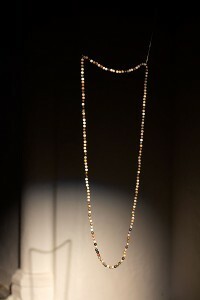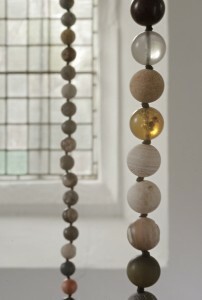At the Wellcome
Caleb Klaces
In a small dark room at the Wellcome Collection, a stranger told me that the necklace we were both looking at through plastic magnifying glasses was one of the most beautiful things she had ever seen.
The necklace was made by Katie Paterson as artist in residence at the Sanger Institute. It is 170 fossils, hand-cut into spheres and arranged in order of age, suspended at eye-height on medical-looking string. The oldest fossil, of archean butterstone stromatolite from present-day South Africa, hangs next to the youngest fossil, from a Cypriot hippo, phanourios minor. The stromatolite is formed of some of the first simple organisms; people were writing in Mesopotamia when the Cyprot hippo was fossilised. Between these points lived woolly rhinos, carcharocles megalodon sharks, dolphins and deer, squid, bison, lobster, mammoths, ink fish, iguanodons, coral, sponge, protozoa, cinnamon trees, winged ants and sea turtle eggs.
I alternated between looking at the beads and trying to catch their coloured surfaces in the magnifying glass. To the naked eye the necklace is a row of humble colours and strange textures. But in the lens it’s dusty orange, black copper, sparkling pink, Mars red, coffee-coloured swirls, bland grey. Not all of the beads are perfect spheres: some are full of holes or flattened on one side. One is half sphere, half radial shell. All of them, though, look exactly right.
The walls of the room at the Wellcome are painted black; and the ceiling, clad in flecked grey tiles, is lowered and darkened with a sheet of black gauze. The work is spot-lit at close range by a glaring light, which casts a shadow like a laughing cartoon mouth. Fossil Necklace was displayed in a church before it came here. I wish I had seen it there. A church, though, is built to house inhuman time. Hung here, the beads seemed to make fun out of us.


Comments
A near neighbour of the Wellcome is the Crypt Gallery, under an old church,
and marking human time with lettered stone. It's not always open, and it shows little-known artists, pieces I can consider purchasing. Even with a weak show the rough walls and floor, tunnels and tiny rooms are always evocative, and some projects fit it very well.
London seethes with visual art, much of the more interesting stuff below radar, in cafes, open studios,"resources centres", swimming pools and other redundant churches.